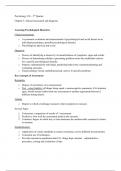Psychology 310 – 2nd Quarter
Chapter 3: clinical assessment and diagnosis
Assessing Psychological Disorders
Clinical assessment
o A systematic evaluation and measurement of psychological and social factors in an
individual presenting a possible psychological disorder.
o Psychological, physical and social
Diagnosis
o Process of identifying a disease by its manifestations of symptoms, signs and results.
o Process of determining whether a presenting problem meets the established criteria
for a specific psychological disorder.
o Purpose: understand the individual, predicting behaviours, treatment planning and
evaluating outcomes.
o Funnel analogy: broad, multidimensional, narrow to specific problems.
Key concepts of Assessment
Reliability
o Degree of consistency of a measurement
o Test – retest liability: all things being equal, a neurocognitive parameter. E.G attention
span, should remain stable from one assessment to another (agreement between 2
different testing times)
Validity
o Degree to which a technique measures what it purports to measure.
Several Types
1. Concurrent: comparison of results of 1 assessment
2. Predictive: how well the assessment predicts the outcome
3. Construct: degree to which test, or item measures the unobservable construct it claims
to measure
Standardisation
o Application of certain standards to ensure consistency across different measurements
o Consistent use of techniques
o Provides normative population data E.G. things kept constant – administrative
procedure, scoring and evaluation of data
,The Clinical Encounter
Access multiple domains
1. Presenting problems
2. Current and past behaviour
3. Detailed history
4. Attitudes and emotions
o Most common clinical assessment
o Structured or semi structured
E.G. of semi structured interview – anxiety disorders interview schedule for DSM-5 has
modules pertaining to anxiety, mood and related disorders, designed to access DSM-5 criteria
Mental state Examination
Brief but systematic overview of global mental functioning across the domains of
consciousness, cognitive functions, emotions, reality testing and behaviour
Domains and features
General appearance
o Mobility, activity, injuries, hygiene, neatness, dress and smell. Engagement,
interaction, co-operation
Consciousness, arousal and cognitive functions
o Level of consciousness
o Arousal
o Attention: focus, sustain, shit, resist distraction
o Memory: for recent info, typically presented verbally
o Language: fluency, understanding, naming, repetition, reading and writing
o Speech: the mechanical production of verbal communication
o Praxis: performance of previously learnt complex motor skills
o Gnosis: recognition of things, across all sensory modalities
o Executive functioning: problem solving, concept formation, planning, organising,
execution and self-monitoring
o Estimate of general intelligence and adaptive functioning
Mood and affect
Mood: depressed, irritable, manic, anxious, labile, reactivity
Affect: nature, congruence, range of expression and reactivity
-melonic tone
- motivation
Reality Testing
o Thinking: speed, coherence, association, logic
, o Thoughts: thought content, ideas, delusions, obsessions
o Acceptance: hallucinations, illusions, misidentification
o Organisations: logical organisation of communication and behaviour
Motoric and other behaviours
o Intensity: aggravation, retardation,
o Adventitious behaviours: stereotypes, mannerisms, tremors, compulsions, catatonia
Physical Examination
Helpful in diagnosing mental health problems
Understand or rule out physical aetiologies
o Toxicities
o Medication side effects
o Allergic reactions
o Metabolic conditions
Physical examination
o Vital signs: blood pressure, pulse, respiration
o General observation: distress, colour, nutrition state, large lymph nodes, bruising,
injuries
o Cardiovascular pulse: exam of the heart, quality of perfusion
o Respiratory: observe chest movement, feel, percuss, listen with stethoscope
o Abdominal: observe, feel, percuss, listen
o Rectal examination
o Pelvic, urological and gynaecological exam
o Musculoskeletal
o Ear, nose, throat and eyes
o Oral cavity and teeth
Behavioural Assessment
Measuring, observing and systematically evaluating the clients thoughts, feeling and
behaviour in the actual problem situation
Behavioural Observation
o Identification and observation of target behaviours
o Target behaviour: behaviour of interest (something that needs to be increased or
decreased)
o Direct observation conducted by assessor (therapist) or by individual/ loved one
o Goal: determine the factors that are influencing target behaviour
The ABC’s of observation
o Antecedents, behaviour, consequences
Self-monitoring
, o Actions by which clients observe and record their own behaviours as either an
assessment or problem and its change or treatment procedure that makes them more
aware of their responses
o Informal or formal (using established rating scales)
o The problem of reactivity: Simply observing a behaviour may cause it to change due
to the individual’s knowledge of being observed
Psychological Testing
o Specific tools for assessment:
o Cognitive, emotion, behaviour
o Include specialised areas such as personality and intelligence
o Projective Test
o Psychologically based measures that present ambiguous stimuli to clients on the
assumption that their responses will reveal their unconscious conflicts
o Rooted in psychological tradition, used to assess unconscious processes, project
aspect of personality onto ambiguous test stimuli, require high degree of inference in
scoring and interpretation.
o E.G.: the Rorschach Inkblot test, Thematic Apperception Test (TAT)
TAT test includes asking a person to tell a dramatic story about a picture (test of imagination)
o Strengths
o May be a useful icebreaker and one way to gather qualitive data
o Criticism
o Hard to standardise, reliability and validity data tend to be mixed
Objective test and personality inventories
Objective test:
o Roots in empirical tradition
o Test stimuli are less ambiguous
o Require minimal clinical inference in scoring and interpretation
Personality inventories:
o Self-report questionnaires that access personal traits by asking respondent to identify
description that applies to them
o Examines the pattern of response to see whether they resemble patterns from groups
of people who have specific disorders
o Minnesota Multiphasic Personality Inventory (MMPI)
o 567 items
o True/ false response
o Criticisms: one of the Qs was racist – someof the items were insensitive to cultural
diversity
o E.G. the lie scale, subtle defensiveness scale, infrequency scale
o Extensive liability, validity and normative database




